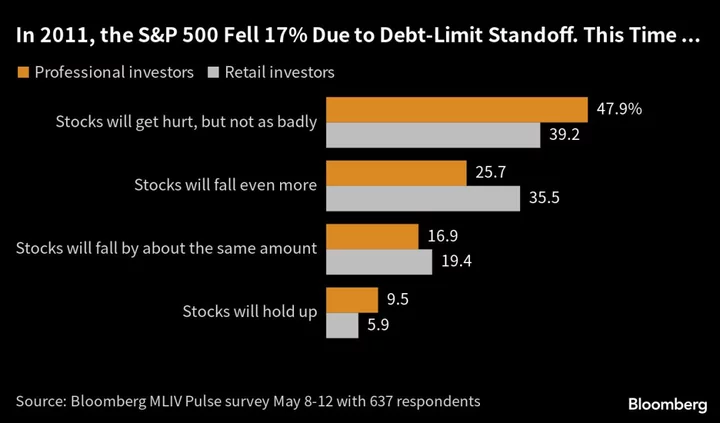The risk of a US debt default is greater than it’s ever been, threatening to tip global markets into a brand-new world of pain. For investors, there are few places to hide other than the oldest hedge in the book: gold.
The precious metal is by far the top pick for those seeking protection in case Washington’s game of chicken over the debt ceiling ends in a crash, according to Bloomberg’s latest Markets Live Pulse survey. More than half of finance professionals said gold is what they would buy if the US government fails to honor its obligations.
Even more striking is the shortage of alternative hedges. The second most popular asset to buy in event of a default, according to the global survey of 637 respondents, was US Treasuries. There’s something of an irony to that given that’s the very thing America would probably be defaulting on.
But it’s worth bearing in mind that even pessimistic analysts see bill holders getting paid— just late — and that in the case of the most fraught debt crisis in previous years, Treasuries rallied even as the US had its top credit rating removed by Standard & Poor’s.
Traditional haven currencies like the Japanese yen and the Swiss franc had some fans, but each were less popular than the US dollar or, perhaps more strikingly Bitcoin, regarded by some investors as a kind of digital gold.
Political and financial bigshots have been lining up to deliver warnings about what might happen if the debt-ceiling impasse isn’t resolved. “The whole world is in trouble,’’ said President Joe Biden. “Potentially catastrophic,’’ said JPMorgan Chase & Co. boss Jamie Dimon. “Very serious repercussions’’ was strong language by the International Monetary Fund’s guarded standards.
A sovereign default by the world’s biggest economy should probably be unthinkable. But it’s definitely thinkable right now.
About 60% of MLIV Pulse respondents said the risks are bigger this time around than in 2011, the worst debt-limit crisis of the past. The cost of insuring against non-payment through one-year credit default swaps has surged well past levels seen in previous episodes, although they still suggest that the actual chance of a default is relatively slim.
“The risk is higher than before, given the polarization of the electorate and the Congress,” said Jason Bloom, head of fixed income, alternatives, and ETF strategies at Invesco. “The way both sides are so dug in, means there is the risk they don’t get their act together in time.”
The gold hedge doesn’t come cheap, as the metal has enjoyed a very good run so far this year. Buoyed first by the growing demand from Chinese luxury buyers, then by a crisis in the banking sector and the threat of US default, it’s currently loitering just shy of its all-time high of $2,075.47 an ounce.
A comfortable majority of investors in the MLIV survey think 10-year Treasuries will rally if the debt ceiling fight goes down to the wire but the US doesn’t default. However, professionals are split over what might happen if the US government actually tumbles over the precipice. About 60% of retail investors expect Treasury 10-year debt to weaken in the case of a default. The yield on the benchmark US note ended last week at 3.46%, around 63 basis points below its high for the year.
In the meantime, the debt ceiling impasse has driven up the yield on some very short-dated securities that are seen as most at risk of a delayed payment, fueling distortions in the bills curve. The most elevated rates are those around early June, close to the point that Treasury Secretary Janet Yellen has warned the US might run out of borrowing headroom. If the department can make it past mid-June, then it’s likely to get a bit of breathing room from expected tax payments and other measures, before facing fresh challenges from late July, where market pricing also indicates a degree of strain and concern.
In the 2011 standoff — which led to a credit rating downgrade by S&P but not an actual default — a surge in Treasury buying took the 10-year yield to a then-record low, while gold rallied and trillions were wiped off global equity values.
Investment professionals are less pessimistic on the outlook for the S&P 500 Index this time than retail traders.
“If we do see a short period of default, the market reaction would put pressure on Congress to raise the debt ceiling,” said Priya Misra, head of rates strategy at TD Securities.
Some investors believe that the debt ceiling drama has already caused some harm to the dollar, and 41% say its standing as the primary global reserve currency is at risk if the US defaults.
The risk of a pivot away from the greenback is something that investors are giving serious consideration. An earlier MLIV Pulse survey showed that a majority of respondents see the dollar making up less than half of global reserves within a decade.
MLIV Pulse is a weekly survey of Bloomberg News readers on the terminal and online, conducted by Bloomberg’s Markets Live team, which also runs a 24/7 MLIV Blog on the terminal. To subscribe to MLIV Pulse stories, click here.
--With assistance from Eddie van der Walt.

